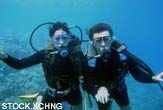Focused Blast of Noise Could Stun Scuba-Diving Terrorists

Rising security concerns have led to a tough question: How can you defend ports and harbors from stealthy, explosives-bearing scuba divers without harming legitimate divers and marine wildlife?
According to new research, the answer could lie in noise. The study, presented Nov. 16 in Cancun, Mexico, at the second Pan-American/Iberian Meeting on Acoustics, recommends a system that would turn a hostile diver into the homing device for a targeted blast of sound loud enough to cause disorientation and dizziness.
The idea of using noise as a weapon is not new. The military already uses acoustic devices on land to disperse crowds and even incapacitate people. And air guns used underwater can produce sounds loud enough to interfere with breathing and cause dizziness. But such air guns radiate sound in all directions, said study author Alexander Sutin of the Stevens Institute of Technology in Hoboken, N.J. Used against a dangerous intruder, the diffuse sound could also potentially stun friendly divers and innocent animals.
To solve the problem, Sutin suggested applying Time Reversal Acoustics, a method of focusing sound waves. Although the physics of TRA are complex, the concept is not: An array of underwater receivers picks up the sound, while transducers (devices that can convert energy from one type to another) re-transmit it back to the source.
In the case of a hostile diver, the system would pick up the unique sound of underwater respirator breathing. The sound of the breathing could be amplified and focused back on the diver in real time. The resulting noise would be a nonlethal but painful deterrent.
"The focus is all on one diver, and does not disturb anything outside of the diver," Sutin told LiveScience.
Using computer models, Sutin and his colleagues mapped out the TRA sound waves as they would travel in the shallow ocean. They found that the focused underwater sound could reach 190 decibels. Noise in water becomes painful at around 150 decibels, Sutin said. (Because water conducts sound better than air, the decibel scales in each medium are different. A sound that registers at 150 decibels in water is equivalent to 125 decibels in air — or about the level of sound emitted by the much-hated World Cup vuvuzelas.)
Sign up for the Live Science daily newsletter now
Get the world’s most fascinating discoveries delivered straight to your inbox.
With just five transmitters dangling in the water, the model system could send out sound waves that would register at 180 decibels 196 feet (60 meters) away. With 10 transmitters, the same level of sound could be heard 656 feet (200 m) away.
The advantage of the TRA system, Sutin said, is that these sounds fade rapidly as you move away from the target, protecting wildlife and anyone else in the water. The systems could be a feasible first line of defense for ports, he said, with lethal force becoming necessary only if the burst of noise fails.
- The 10 Most Outrageous Military Experiments
- Top 10 Animal Recruits in War
- Top 10 Greatest Explosions Ever

Stephanie Pappas is a contributing writer for Live Science, covering topics ranging from geoscience to archaeology to the human brain and behavior. She was previously a senior writer for Live Science but is now a freelancer based in Denver, Colorado, and regularly contributes to Scientific American and The Monitor, the monthly magazine of the American Psychological Association. Stephanie received a bachelor's degree in psychology from the University of South Carolina and a graduate certificate in science communication from the University of California, Santa Cruz.









